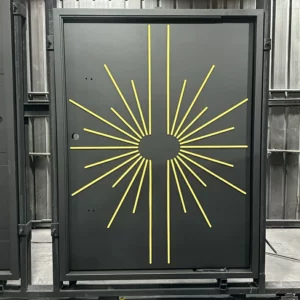The alignment of the overall aesthetic of an exterior iron gate with the property’s architectural style and landscape is crucial for a cohesive and harmonious look.
Here’s how the aesthetic considerations are typically addressed:
- Architectural Compatibility: The design of the iron gate should complement the architectural style of the property. For instance, traditional or ornate ironwork might suit historic or classical architecture, while sleek and minimalist designs could complement modern or contemporary buildings.
- Consistency in Design Language: The gate’s design, whether it features intricate scrollwork, geometric patterns, or minimalist lines, should echo or complement elements found elsewhere in the property’s architecture, such as window grilles, balconies, or fencing.
- Materials and Finishes: The choice of finishes and materials should harmonize with the property’s exterior materials. Whether it’s matching the color of the gate to the facade, or coordinating with stone, brick, or wood elements, the gate should blend seamlessly with the surroundings.
- Scale and Proportion: The size and scale of the gate should be in proportion to the property’s entrance and overall structure. Oversized gates might overpower smaller properties, while undersized gates could appear insignificant on larger estates.
- Landscape Integration: The gate design should consider the property’s landscaping. Gates adorned with nature-inspired motifs or shapes might complement lush gardens, while geometric or contemporary designs could suit more minimalist landscaping.
- Visual Impact: The gate’s design should contribute positively to the property’s curb appeal. It should make a statement without overpowering the overall visual harmony of the property.
- Customization for Uniqueness: Customizing the gate design allows for personalized touches that reflect the owner’s preferences while aligning with the property’s aesthetics.
- Cultural and Regional Influences: Some areas have specific architectural styles or cultural influences that should be considered when designing the gate, ensuring it fits harmoniously within the local context.
- Balance Between Function and Form: While aesthetics are important, ensuring that the gate meets functional needs, such as security and ease of use, without sacrificing its aesthetic appeal is crucial.
By paying attention to these aesthetic considerations, an exterior iron gate can serve as an architectural focal point, enhancing the property’s overall appearance, complementing its style, and integrating harmoniously with the landscape and architectural elements.
What are the design elements that ensure the longevity and structural strength of an exterior iron gate?
Design elements that ensure the longevity and structural strength of an exterior iron gate include:
- Material Quality: Starting with high-quality materials, such as wrought iron or galvanized steel, ensures the gate’s durability against rust, corrosion, and weathering.
- Solid Construction: The gate’s construction should prioritize strength and stability. Sturdy frames, reinforced corners, and welded joints contribute to its structural integrity.
- Appropriate Thickness: The thickness of the iron used in the gate’s construction affects its strength. Opting for thicker gauges enhances its resilience against bending or warping.
- Reinforcements: Adding reinforcements, such as internal bracing or additional bars strategically placed within the gate’s design, can bolster its strength without compromising aesthetics.
- Proper Welding Techniques: High-quality welding techniques and craftsmanship ensure secure and long-lasting joints, minimizing weak points susceptible to damage.
- Weatherproof Finishes: Applying weather-resistant finishes, such as powder coating, galvanization, or specialized paint, protects the iron from moisture, suitable exterior iron gate price UV rays, and harsh weather conditions, preventing rust and corrosion.
- Careful Design Considerations: The gate’s design should account for stress points and potential weak areas, aiming to distribute weight and stress evenly throughout the structure.
- Supporting Hardware: Choosing high-quality hinges, locks, and other supporting hardware components that are corrosion-resistant and durable contributes to the gate’s overall longevity.
- Regular Maintenance: Establishing a maintenance routine, such as cleaning, inspecting for signs of wear or damage, and applying protective coatings, prolongs the gate’s lifespan.
- Appropriate Installation: Proper installation, including secure anchoring and alignment, ensures the gate functions as intended and reduces the risk of premature wear or damage.
- Strategic Drainage: Designing the gate with proper drainage systems, ensuring water doesn’t accumulate within its structure, prevents rust and extends its lifespan.
- Load-Bearing Capacity: If the gate is motorized or bears heavy loads (e.g., larger gates), ensuring it’s designed to handle these loads without compromising its structural integrity is crucial.
By incorporating these design elements into the creation and installation of an exterior iron gate, its structural strength and longevity can be significantly enhanced, ensuring it stands the test of time and environmental factors.
